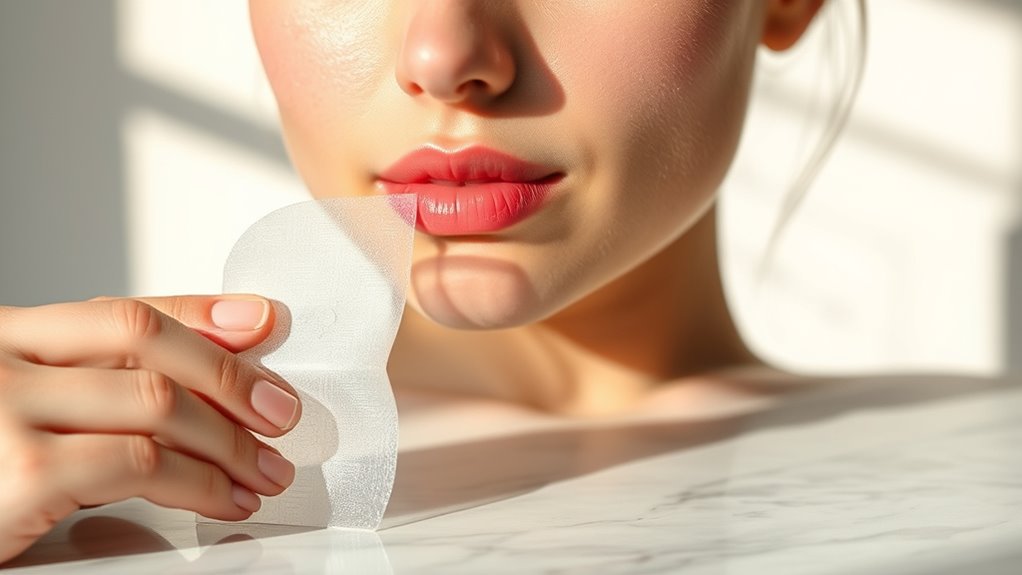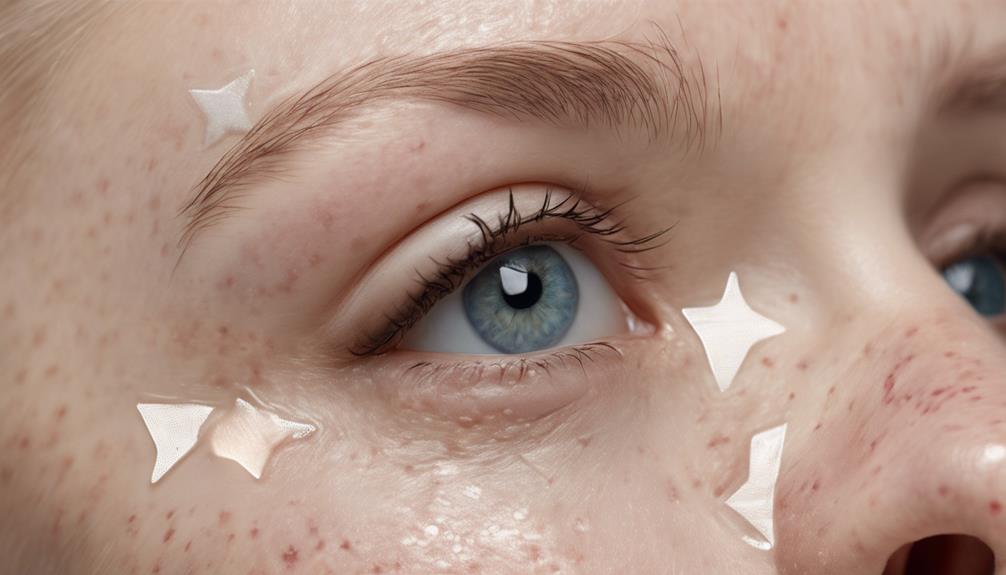You should take off your pimple patches once they turn opaque or white, indicating saturation. If the edges start peeling or the patch loses stickiness, it’s time to remove it. Generally, aim to wear your patches for at least 6 to 8 hours, but no longer than 10 to prevent skin irritation. Clean and dry skin is essential for maximum effectiveness. Want to learn more about applying and caring for your patches?
Key Takeaways
- Remove the patch when it turns opaque or white, indicating it has absorbed fluids and is saturated.
- If edges start peeling off or the patch loses stickiness, it’s time to take it off.
- Monitor for any redness or itching around the patch, as this suggests skin irritation.
- Aim to wear patches for at least 6 to 8 hours for optimal results, but no longer than 10 to avoid irritation.
- Always apply patches on clean, dry skin, and avoid makeup or oily products underneath for better adhesion.
Understanding Pimple Patch Duration

When you’re using pimple patches, understanding how long to leave them on is crucial for getting the best results. Most patches work effectively when left on for 6 to 8 hours, but if you want continuous treatment, consider wearing them overnight for 8 to 12 hours. Some patches can even stay on for up to 24 hours, although you should check them regularly. The duration can vary based on the type of patch you choose and your specific skin condition. Hydrocolloid patches are great for absorbing fluids, while medicated or microneedle patches tackle stubborn acne. Always remove the patch when it becomes saturated or loses effectiveness to guarantee you’re getting the most out of your treatment. Hydrocolloid patches are most effective on whiteheads, the final stage of a pimple’s life cycle.
Signs It’s Time to Remove Your Patch
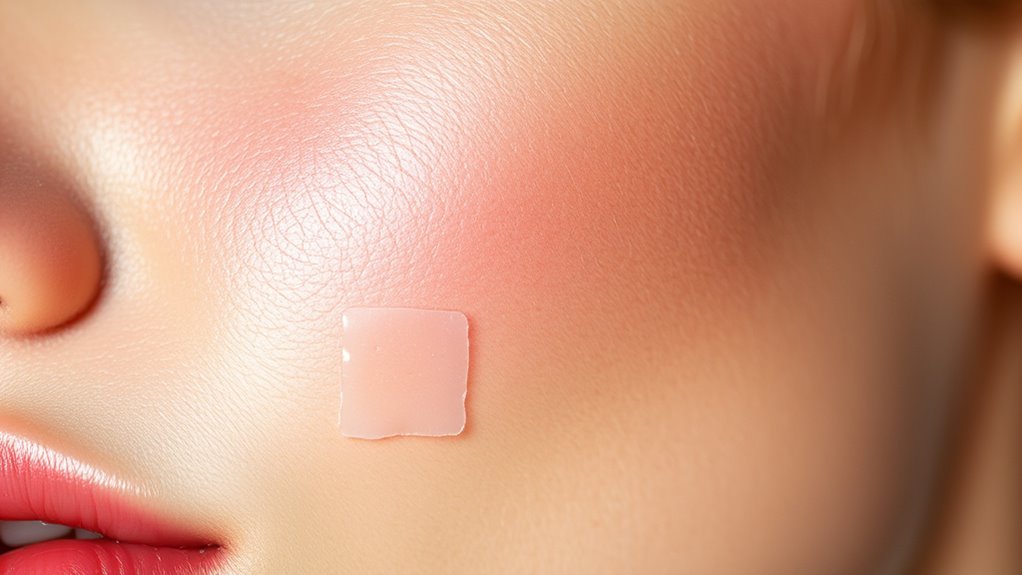
Knowing when to remove your pimple patch is essential for maximizing its effectiveness. Look for visible changes: if the patch turns opaque or white, it’s absorbed all it can. Edges peeling off? That’s another sign it’s time for removal. If the patch loses its stickiness or falls off, it’s no longer effective, and poor adhesion can lead to irritation. Keep an eye out for redness or itching around the patch; persistent irritation suggests it’s best to remove and reapply later. Generally, patches should be worn for several hours or overnight, but exceeding 8-10 hours might irritate your skin. Remember, hydrocolloid technology helps create a protective barrier over blemishes, which further emphasizes the importance of timely removal. Always follow up with gentle cleansing and moisturizing for peak skin health post-removal.
Best Practices for Patch Application
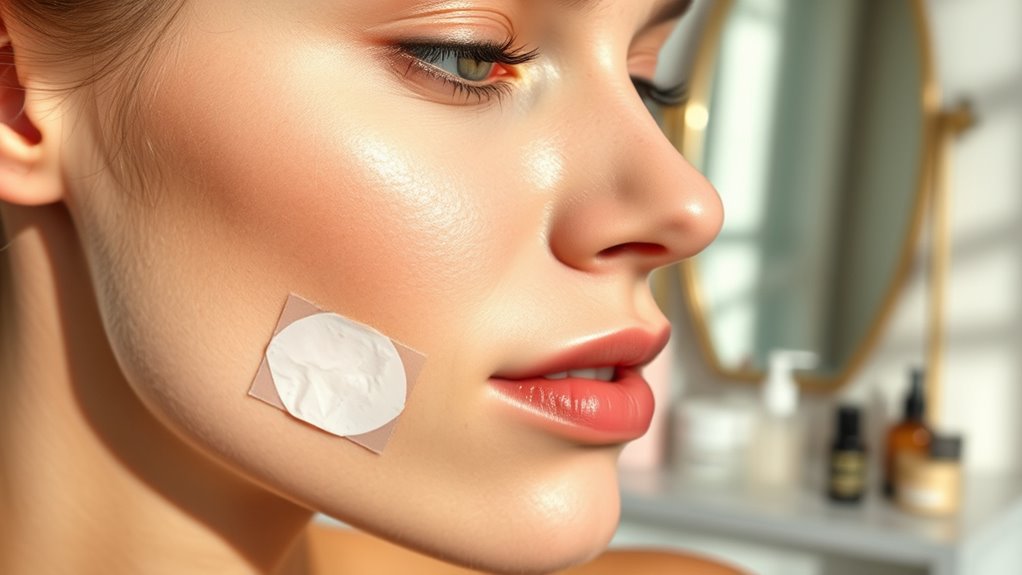
To achieve the best results with pimple patches, start by verifying your skin is perfectly clean and dry before application. This enhances adhesion and effectiveness. A clean, dry face creates an ideal surface for patch adherence.
Choose a patch that covers the pimple and a small surrounding area. Once placed, press down firmly for 20-30 seconds to secure it in place and avoid air bubbles.
Select a patch that envelops the pimple and surrounding skin, then press firmly for 20-30 seconds to ensure a secure fit.
Remember, don’t apply patches over makeup or oily skincare products as this can hinder their performance.
For ideal hygiene, confirm your hands are clean before handling the patches, and consider using tweezers if you have long nails.
Following these best practices will help you maximize the benefits of pimple patches while minimizing the risk of irritation or failure.
Preparing Your Skin for Pimple Patches

Achieving the best results with pimple patches starts with properly preparing your skin.
Begin by cleansing your face with a gentle, non-comedogenic cleanser to remove dirt and makeup. After cleansing, pat your skin dry to guarantee the patches adhere well without moisture interference. It’s crucial to choose the right pimple patch based on your skin’s needs to enhance the treatment’s effectiveness.
It’s important to avoid heavy, oily moisturizers right before applying the patches. Instead, consider using a gentle toner to refresh your skin without adding excess moisture.
Handle the affected areas delicately to prevent irritation, allowing the patches to work effectively.
Common Mistakes to Avoid With Pimple Patches
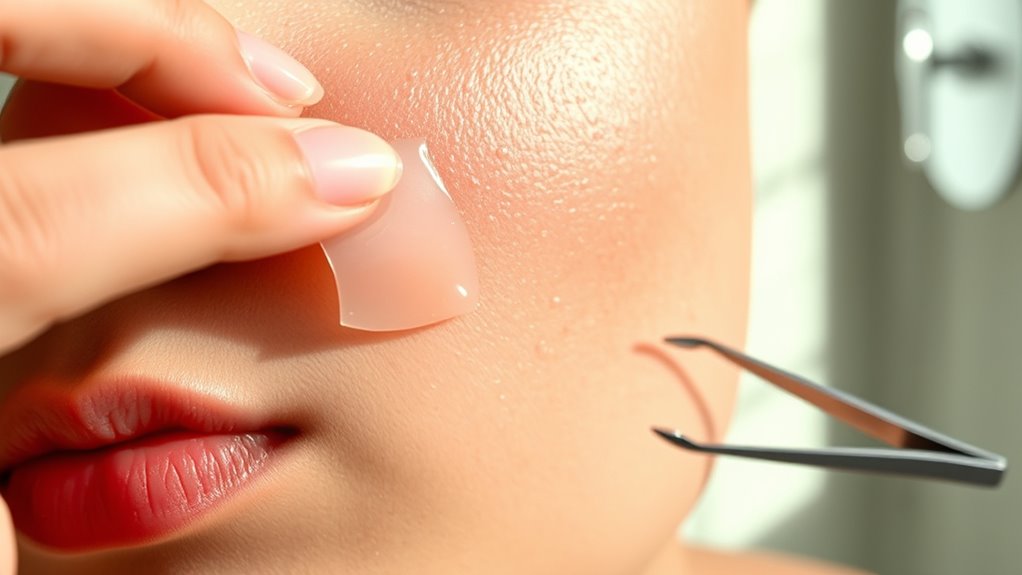
While using pimple patches can be an effective way to treat breakouts, there are common mistakes that can hinder their performance.
First, don’t leave patches on for too short a duration; aim for at least six hours. Conversely, remember to remove them once they turn opaque to avoid irritation.
Aim to keep pimple patches on for at least six hours, but remove them once they turn opaque to prevent irritation.
Make sure you’re applying patches to the right type of acne; they work best on visible pimples, not cystic ones or blackheads. Hydrocolloid patches absorb excess fluid from pimples, enhancing their healing process.
Also, avoid oil-based products and makeup underneath to maintain adhesion. Handle patches with clean hands, and never reuse them.
Finally, choose patches based on your skin’s needs and the specific breakouts you’re treating to maximize their effectiveness.
Avoid these mistakes for clearer skin!
Frequently Asked Questions
Can I Use Multiple Patches at Once?
Yes, you can use multiple patches at once! They work great for managing widespread breakouts and can cover separate pimples effectively.
Just make sure to choose patches suited for your skin type and the severity of your acne. Applying different patches can help absorb impurities and enhance healing.
Remember to clean and dry your skin before application, and allow the patches to stay on for ideal results, usually around 6-8 hours.
How Do I Choose the Right Patch Size?
Choosing the right patch size is like finding the perfect pair of jeans; you want a snug fit without discomfort.
You should select a patch slightly larger than your pimple to guarantee adequate coverage and adhesion. Remember, if it’s too small, it won’t do much, and if it’s too large, it might irritate surrounding skin.
Always apply the patch on clean, dry skin for the best results. Your skin will thank you!
Are There Any Side Effects of Using Pimple Patches?
Yes, there are side effects of using pimple patches. You might experience skin irritation like redness or dryness, especially if you have sensitive skin.
Allergic reactions to the adhesive or ingredients can also occur. In some cases, using patches too long may lead to hyperpigmentation or blisters.
To minimize risks, conduct a patch test and use gentle skincare products. Always follow the manufacturer’s instructions for application and removal.
Can I Apply Makeup Over Pimple Patches?
Yes, you can apply makeup over pimple patches without compromising their effectiveness.
The hydrocolloid patches provide a smooth surface, making it easier to blend your makeup and conceal blemishes.
Just make sure your skin is clean and dry before applying the patch.
Use a light hand with foundation and concealer to avoid displacing the patch.
This way, you can protect the pimple while achieving a flawless look.
How Often Can I Use Pimple Patches in a Week?
It’s funny how you can cover a pimple with a patch, yet still wonder how often you can use them in a week.
You can use pimple patches daily if your breakouts persist, but listen to your skin. If it’s sensitive, you might want to ease up.
Aim for 4-8 hours of wear, replacing them when they turn white.
Just remember, moderation’s key to avoid irritation while tackling those pesky pimples effectively!
Conclusion
In the quest for picture-perfect skin, timing is everything with pimple patches. Just like a flower blooms in its own time, you’ll know when to peel away the patch by observing your skin’s response. Once the patch has done its magic, remove it gently and reveal the refreshed skin underneath. By following best practices and avoiding common mistakes, you can guarantee your skin shines like a star in your next photo. Happy patching!
